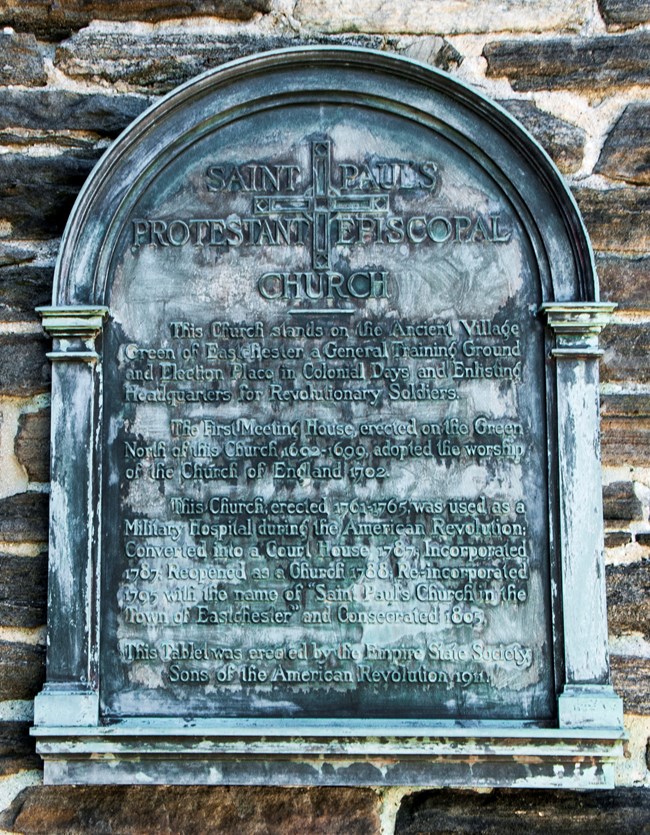Last updated: January 17, 2022
Article
Bronze Plaque Reflects an earlier understanding of venerating St. Paul's Church

NPS
Bronze Plaque reflects an earlier Veneration of St. Paul’s Church
A small metal plaque attached to the masonry at the northern side of the tower of St. Paul’s reflects the early 20th century veneration of the church’s connection to the American Revolution and also the efforts of heritage organizations to perpetuate the memory of the generation that achieved independence.
The tablet was dedicated on July 4, 1911. The bronze plaque was a gift to St. Paul’s from the Empire State Society of the Sons of the American Revolution (SAR), a patriotic, hereditary society of men who traced ancestry to a participant in the struggle for independence of 1776-1783. Founded on April 30, 1889 -- the 100th anniversary of George Washington’s inauguration as the first President -- the SAR developed in a parallel relationship with the Daughters of the American Revolution (DAR) as volunteer associations designed to preserve the history and ideals of the American Revolution. At the time, the United States was emerging as a world power, and an honored, glorious founding helped anchor the nation. It also was a period of record immigration and SAR membership facilitated a confirmation of their status as special Americans through a connection to the nation’s origins.
By 1911, St. Paul’s was already recognized as an exceptional place with an intrinsic link to the American Revolution. An appreciation of this identification with the Revolution was fostered by Father William S. Coffey, the church’s rector for 57 years, from 1852 to 1909. A gentleman historian, Rev. Coffey wrote and spoke widely about .the history of the church in the context of the Revolutionary struggle. Even though he had died two years before at age 77, Rev. Coffey was referenced in the ceremony unveiling the plaque on a steamy morning. Established in the 1880s, the Independence Day commemoration had gained popularity as a local tradition, with an emphasis on the importance of setting.
While the DAR sponsored an array of educational and patriotic campaigns, the much smaller SAR focused more exclusively on preserving the legacy and footprint of the Revolutionary War. Among their activities was an annual July 4th wreath laying at the tomb of Lafayette in Paris, recognizing the marquis’ contribution to the American Revolution. The Empire Society also lobbied for preservation of sites in New York associated with the Revolution. In the year when they sponsored the St. Paul’s tablet, for instance, the men campaigned for protection of the Saratoga battlefield, conservation of the Newburg headquarters of General Henry Knox and establishment of Alexander Hamilton’s former mansion in Harlem as a museum. These major, long term projects required considerable political action and funding, while erecting a modest tablet on a church with a connection to the American Revolution was a tangible, achievable contribution to preserving the narrative of the war.
The text of the plaque suggests the understanding of the historical significance of St. Paul’s in the early 20th century. Designed by the SAR, in co-operation with the church rector, it lists Revolutionary War activities on the grounds, but also enshrines the history of the parish. While Church authorities obviously welcomed the contribution, they wanted the inscription to chronicle the record of the church as a venerable institution established on the “ancient” village green. Strikingly, there is no reference to the Election of 1733, which beginning in the 1930s was heralded as a milestone in the development of freedom of the press and religion in early America.
The SAR gift was unveiled as part of the traditional Independence Day celebration at St. Paul’s, drawing a crowd of about 300, despite temperatures near 100 degrees. A small monument, the tablet’s perimeter measures 27” x 37”, although the upper third is curved to form a semi-circle in the image of gravestones of the day. It cost $151.50, or about $3,700 in today’s value. Still visible in its original location about 6 feet off the ground, the inscription reads:
"Saint Paul’s Protestant Episcopal Church
"This Church stands on the Ancient Village Green of Eastchester, a General Training Ground and Election Place in Colonial Days and Enlisting Headquarters for Revolutionary Soldiers. The first Meeting House erected on the Green North of this Church, 1692- 1699, adopted the worship of the Church of England 1702. This Church, erected 1761-65, was used as a Military Hospital during the American Revolution; Converted into a Court House 1787; Incorporated 1787; Re-opened as a Church 1788; Re-incorporated 1795 with the name of “Saint Paul’s Church in the Town of Eastchester” and Consecrated 1805.
"This Tablet was erected by the Empire State Society of the Sons of the American Revolution 1911."
